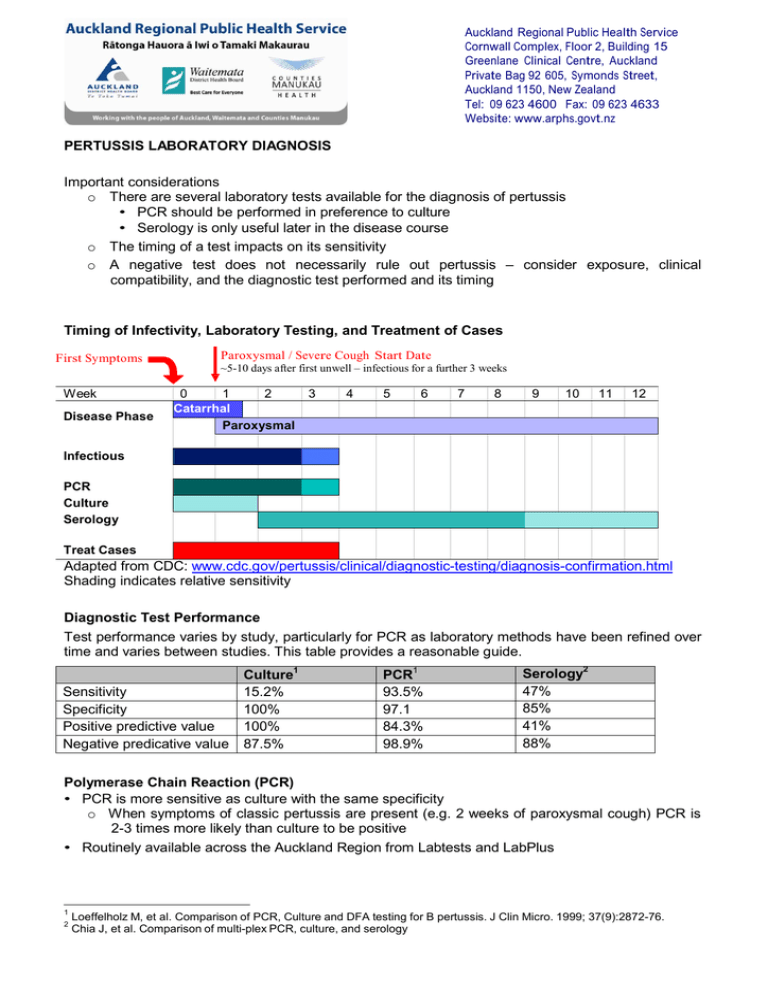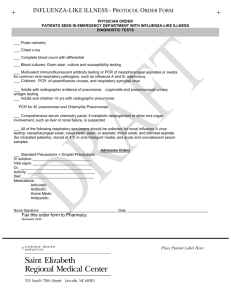Pertussis Laboratory Diagnosis
advertisement

Auckland Regional Public Health Service Cornwall Complex, Floor 2, Building 15 Greenlane Clinical Centre, Auckland Private Bag 92 605, Symonds Street, Auckland 1150, New Zealand Tel: 09 623 4600 Fax: 09 623 4633 Website: www.arphs.govt.nz PERTUSSIS LABORATORY DIAGNOSIS Important considerations o There are several laboratory tests available for the diagnosis of pertussis • PCR should be performed in preference to culture • Serology is only useful later in the disease course o The timing of a test impacts on its sensitivity o A negative test does not necessarily rule out pertussis – consider exposure, clinical compatibility, and the diagnostic test performed and its timing Timing of Infectivity, Laboratory Testing, and Treatment of Cases First Symptoms Week Disease Phase Paroxysmal / Severe Cough Start Date ~5-10 days after first unwell – infectious for a further 3 weeks 0 1 2 Catarrhal Paroxysmal 3 4 5 6 7 8 9 10 11 12 Infectious PCR Culture Serology Treat Cases Adapted from CDC: www.cdc.gov/pertussis/clinical/diagnostic-testing/diagnosis-confirmation.html Shading indicates relative sensitivity Diagnostic Test Performance Test performance varies by study, particularly for PCR as laboratory methods have been refined over time and varies between studies. This table provides a reasonable guide. Sensitivity Specificity Positive predictive value Negative predicative value Culture1 15.2% 100% 100% 87.5% PCR1 93.5% 97.1 84.3% 98.9% Serology2 47% 85% 41% 88% Polymerase Chain Reaction (PCR) • PCR is more sensitive as culture with the same specificity o When symptoms of classic pertussis are present (e.g. 2 weeks of paroxysmal cough) PCR is 2-3 times more likely than culture to be positive • Routinely available across the Auckland Region from Labtests and LabPlus 1 2 Loeffelholz M, et al. Comparison of PCR, Culture and DFA testing for B pertussis. J Clin Micro. 1999; 37(9):2872-76. Chia J, et al. Comparison of multi-plex PCR, culture, and serology Auckland Regional Public Health Service Cornwall Complex, Floor 2, Building 15 Greenlane Clinical Centre, Auckland Private Bag 92 605, Symonds Street, Auckland 1150, New Zealand Tel: 09 623 4600 Fax: 09 623 4633 Website: www.arphs.govt.nz • Performed on a flocked nasopharyngeal swab placed in viral transport media Culture • Only useful during the catarrhal and very early paroxysmal phase • Lower sensitivity compared to PCR • Routinely available across the Auckland Region from Labtests and LabPlus • Performed on a charcoal nasopharyngeal swab • Culture sensitivity is reduced by antibiotic treatment, immunisation, time since onset of symptoms, delay in transportation to the laboratory Serology • Serology is only useful late in the course of the illness, generally when the patient is no longer infectious, providing retrospective diagnosis • Serology is not useful in the 12 months after vaccination as the antibody response following vaccination mimics that following infection • Positive IgG results include o A single IgG titre against anti-pertussis toxin in the context of a recent clinically compatible illness and in the absence of immunisation in the preceding 12 months. Consider pertussis in the presence of the following local laboratory results: o IgG Moderate Positive: 31-60 BU/ml o IgG Strong Positive: >61 BU/ml o A four-fold rise in IgG between acute and convalescent sera taken 4-6 weeks apart in the absence of recent immunisation • IgA assays lack adequate sensitivity and specificity and should not be used for diagnosis Nasopharyngeal Swab Technique • Gently insert the nasopharyngeal swab into the nostril until it reaches the posterior nasopharynx o there may be a slight resistance as the swab passes the turbinates o if there is more than slight resistance do not force the swab but try the other nostril • Leave the swab in place for a few seconds. • Gently withdraw the swab and place into transport medium immediately • Note it is common for the tickling sensation of the swab to produce a cough or sneeze and it is useful to have a paper tissue handy.




